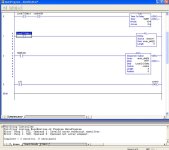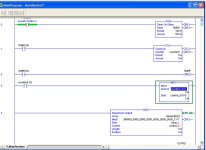Array troubles
- Thread starter [email protected]
- Start date
Similar Topics
Hi, I'm having an issue in crimson 3.0 when I create a programme using a case statement referencing a fault word that each bit needs to change the...
I am trying to copy an array of real numbers into a UDT with a real data type element. I have attached a snip below showing my COP instruction...
I have an array of 55 REAL values. Is there a way to multiply based on the array location ?
I have 55 transfer belts that are equally spaced...
Hello everyone,
I'm working on a project that involves controlling an array of nozzles within a CNC environment, where the nozzles travel along a...
Hi.
I'm using a Modbus ProSoft where I basically map data to a big INT array.
Example, where GX_I_63HPU is a REAL, MNETC.DATA.WriteData[200] an...





